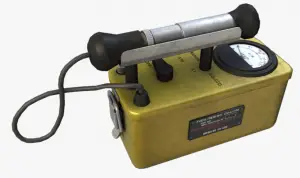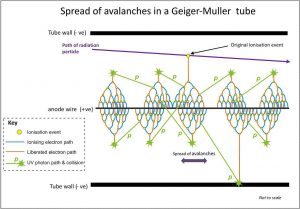
The Geiger counter, also known as the Geiger-Mueller counter, is an electrical device that detects various types of ionizing radiation. This device is named after the two physicists who invented the counter in 1928, and Mueller was a student of Hans Geiger. Geiger counter is widely used in applications such as radiation dosimetry, radiological protection, experimental physics, and the nuclear industry. A Geiger counter consists of a Geiger-Müller tube (the sensing element which detects the radiation) and the processing electronics, which displays the result.
Geiger counter can detect ionizing radiation such as alpha and beta particles, neutrons, and gamma rays using the ionization effect produced in a Geiger–Müller tube, which gives its name to the instrument. The voltage of the detector is adjusted so that the conditions correspond to the Geiger-Mueller region.

Detection of Alpha, Beta, and Gamma Radiation using Geiger-Mueller Counter
Geiger counters are mainly used for portable instrumentation due to their sensitivity, simple counting circuit, and ability to detect low-level radiation. Although the major use of Geiger counters is probably in individual particle detection, they are also found in gamma survey meters. They can detect almost all types of radiation, but there are slight differences in the Geiger-Mueller tube. However, the Geiger-Müller tube produces a pulse output of the same magnitude for all detected radiation, so a Geiger counter with an end window tube cannot distinguish between alpha and beta particles.
There are two main types of Geiger tube construction:
- End-Window type. For alpha and beta particles to be detected by Geiger counters, they must be given a thin window. This “end-window” must be thin enough for the alpha and beta particles to penetrate. However, a window of almost any thickness will prevent an alpha particle from entering the chamber. The window is usually made of mica with a density of about 1.5 – 2.0 mg/cm2 to allow low-energy beta particles (e.g., from carbon-14) to enter the detector. The efficiency reduction for alpha is due to the attenuation effect of the end window, though the distance from the surface being checked also has a significant effect. Ideally, a source of alpha radiation should be less than 10mm from the detector due to attenuation in the air.
- Windowless type. Gamma rays have very little trouble penetrating the metal walls of the chamber. Therefore, Geiger counters may be used to detect gamma radiation and X-rays (thin-walled tubes) collectively known as photons, and for this, the windowless tube is used.
- A thick-walled tube is used for gamma radiation detection above energies of about 25 KeV, and this type generally has an overall wall thickness of about 1-2 mm of chrome steel.
- A thin-walled tube is used for low-energy photons (X-rays or gamma rays) and high-energy beta particles. The transition from thin-walled to thick-walled design takes place at the 300–400 keV energy levels. Above these levels, thick-walled designs are used, and beneath these levels, the direct gas ionization effect is predominant.
Sometimes, a “pancake” design of the Geiger-Mueller tube is preferred. This detector is a flat Geiger tube with a thin mica window of a larger area. Flat Geiger tubes like this are known as “pancake” tubes. Such tubes are fitted with a wire screen to protect them. This design provides a larger detecting area and thus higher efficiency to make checking quicker. However, the pressure of the atmosphere against the low pressure of the fill gas limits the window size due to the limited strength of the window membrane.